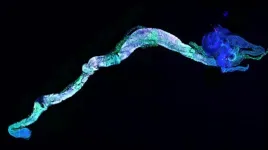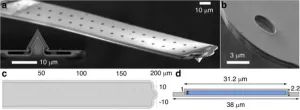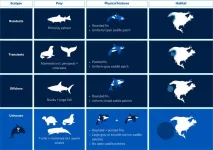(Press-News.org) COLUMBUS, Ohio – Eating fatty food in the days leading up to surgery may prompt a heightened inflammatory response in the brain that interferes for weeks with memory-related cognitive function in older adults – and, new research in animals suggests, even in young adults.
The study, building upon previous research from the same lab at The Ohio State University, also showed that taking a DHA omega-3 fatty acid supplement for a month before the unhealthy eating and surgical procedure prevented the effects on memory linked to both the high-fat diet and the surgery in aged and young adult rats.
Three days on a high-fat diet alone was detrimental to a specific type of fear-related memory in aged rats for as long as two weeks later – the same type of impairment seen in younger rats that ate fatty food and had a surgical procedure. The team has traced the brain inflammation behind these effects to a protein that activates the immune response.
“These data suggest that these multiple insults have a compounding effect,” said senior author Ruth Barrientos, an investigator in Ohio State’s Institute for Behavioral Medicine Research and associate professor of psychiatry and behavioral health and neuroscience in the College of Medicine.
“We’ve shown that an unhealthy diet, even in the short term, especially when it’s consumed so close to a surgery, which in and of itself will cause an inflammatory response, can have damaging results,” Barrientos said. “The high-fat diet alone might increase inflammation in the brain just a little bit, but then you have surgery that does the same thing, and when put together in a short amount of time you get a synergistic response that can set things in motion toward a longer-term memory issue.”
The study was published recently in the journal Brain, Behavior, and Immunity.
Barrientos’ lab studies how everyday life events might trigger inflammation in the aging brain as the nervous system responds to signals from the immune system reacting to a threat. Decades of research has suggested that with aging comes long-term “priming” of the brain’s inflammatory profile and a loss of brain-cell reserve to bounce back.
Researchers fed young adult and aged rats a diet high in saturated fat for three days before a procedure resembling exploratory abdominal surgery – an event already known to cause about a week of cognitive issues in an older brain. Control rats ate regular food and were anesthetized, but had no surgery. (Barrientos’ lab has determined anesthesia alone does not cause memory problems in rats.)
In this study, as in previous research on aged rats treated with morphine after surgery, the team showed that an immune system receptor called TLR4 was the culprit behind the brain inflammation and related memory problems generated by both surgery and the high-fat diet, said first author Stephanie Muscat, assistant clinical professor of neuroscience at Ohio State.
“Blocking the TLR4 signaling pathway prior to the diet and surgery completely prevented that neuroimmune response and memory impairments, which confirmed this specific mechanism,” Muscat said. “And as we had found before in another model of an unhealthy diet, we showed that DHA supplementation did mitigate those inflammatory effects and prevent memory deficits after surgery.”
There were some surprising memory findings in the new work. Different behavioral tasks are used to test two types of memory: contextual memory based in the hippocampus and cued-fear memory based in the amygdala. In contextual memory tests, rats with normal memory freeze when they re-enter a room in which they had an unpleasant experience. Cued-fear memory is evident when rats freeze in a new environment when they hear a sound connected to that previous bad experience.
For aged rats in this study, as expected, the combination of a high-fat diet and surgery led to problems with both contextual and cued-fear memory that persisted for at least two weeks – a longer-lasting effect than the researchers had seen before.
The high-fat diet alone also impaired the aging rats’ cued-fear memory. And in young adult rats, the combination of the high-fat diet and surgery led to only cued-fear memory deficits, but no problems with memory governed by the hippocampus.
“What this is telling us in aged animals, along with the fact we’re seeing this same impairment in young animals after the high-fat diet and surgery, is that cued-fear memory is uniquely vulnerable to the effects of diet. And we don’t know why,” Barrientos said. “One of the things we’re hoping to understand in the future is the vulnerability of the amygdala to these unhealthy diet challenges.”
With increasing evidence suggesting that fatty and highly processed foods can trigger inflammation-related memory problems in brains of all ages, the consistent findings that DHA – one of two omega-3 fatty acids in fish and other seafood and available in supplement form – has a protective effect are compelling, Barrientos said.
“DHA was really effective at preventing these changes,” she said. “And that’s amazing – it really suggests that this could be a potential pretreatment, especially if people know they’re going to have surgery and their diet is unhealthy.”
This work was supported by grants from the National Institute on Aging and the National Institute of Neurological Disorders and Stroke.
Co-authors included Michael Butler, Menaz Bettes, James DeMarsh, Emmanuel Scaria and Nicholas Deems, all of Ohio State.
#
Contacts:
Ruth Barrientos, ruth.barrientos@osumc.edu
Stephanie Muscat, stephanie.muscat@osumc.edu
Written by Emily Caldwell, Caldwell.151@osu.edu; 614-292-8152
END
Adhesion GPCRs belong to the large family of G protein-coupled receptors (GPCRs). There are about 700 variants in humans, which are responsible for sensory impressions, hormonal cycles, controlling the cardiovascular system and more. GPCRs translate stimuli that hit a cell from outside into an intracellular biochemical signal.
The use of the fruit fly as a model animal allows researchers in this field to gain a deep understanding of human diseases, because the animals are genetically very similar to humans. Scientists estimate that around 75 per cent of the genes involved in human diseases ...
The current theoretical model for the composition of the universe is that it’s made of ‘normal matter,’ ‘dark energy’ and ‘dark matter.’ A new uOttawa study challenges this.
A University of Ottawa study published today challenges the current model of the universe by showing that, in fact, it has no room for dark matter.
In cosmology, the term “dark matter” describes all that appears not to interact with light or the electromagnetic field, or that can only be explained through gravitational force. We can’t see it, nor do we know what ...
A study introduces a novel method for calibrating the spring constant of FluidFM micropipette cantilevers, crucial for the accurate measurement of forces in microfluidic environments. This method addresses the limitations of current calibration techniques, offering a significant advancement in the field of force microscopy.
Fluidic force microscopy (FluidFM) combines the sensitivity of atomic force microscopy with microfluidics' capabilities, necessitating precise calibration of its cantilevers for reliable data. Traditional methods, however, struggle with the unique internal structure of FluidFM cantilevers, leading to ...
A recent study published in the Journal of Geographical Sciences in December 2023 reveals a novel method for reconstructing historical warm season temperatures in North China. Utilizing the blue intensity (BI) of tree rings of Picea meyeri, researchers have developed a 281-year chronology, offering unprecedented insights into the region’s climatic past.
The escalating public concern over climate warming, due to its significant impacts on society, ecosystems, and the environment, underscores the importance of understanding long-term climatic conditions across different regions. As the limited observational records constrain our comprehensive grasp of climate change, tree-ring data prove ...
Funding will prepare three scientists to improve sustainable development in their country
The University has won British Council International Science Partnerships funding of £180,000
The University already has close ties with the sustainability sector in the Philippines.
Aston University is to help tackle sustainability problems in the Philippines by offering training to three of the country’s early career researchers.
The University has won British Council International Science Partnerships funding of £180,000 to host three scientists ...
A new study reveals a significant increase in aboveground carbon (AGC) in Southwest China from 2013 to 2021, defying the adverse effects of extreme droughts. This achievement underscores the region's pivotal role as a carbon sink, attributed to extensive ecological projects and innovative remote sensing techniques.
Over the past four decades, Southwest China has been a major carbon sink, significantly mitigating anthropogenic CO2 emissions. However, recent severe droughts, especially from 2009-2013 and in 2022, have drastically reduced its carbon ...
About The Study: This study quantified the potential savings from eliminating or reducing physical activity disparities, which can help policymakers, health care systems, schools, funders, sports organizations, and other businesses better prioritize investments toward addressing these disparities.
Authors: Bruce Y. Lee, M.D., M.B.A., of Public Health Informatics, Computational, and Operations Research (PHICOR), CUNY Graduate School of Public Health and Health Policy in New York, is the corresponding author.
To ...
About The Study: Greater exposure to early-life pain was associated with altered maturation of neonatal structural connectivity, particularly in female infants in this study of 150 very preterm infants. Alterations in structural connectivity were associated with neurodevelopmental outcomes, with potential regional specificities.
Authors: Steven P. Miller, M.D.C.M., M.A.S., of the BC Children’s Hospital Research Institute and University of British Columbia in Vancouver, is the corresponding author.
To ...
What would happen if the existing disparities in physical activity levels between youth of lower and higher socioeconomic statuses were eliminated? Previous studies have shown that those between 6-17 years of age in lower socioeconomic groups get on average 10-15% less physical activity than those of higher socioeconomic groups. A new study published in the journal JAMA Health Forum on Mar. 15 shows that eliminating such disparities could end up saving society over $15 billion in direct medical costs and productivity losses. This in turn could end up benefiting all taxpayers, anyone who pays insurance ...
UBC researchers believe a group of killer whales observed hunting marine mammals including sperm whales, as well as a sea turtle, in the open ocean off California and Oregon could be a new population.
Based on available evidence, the researchers posit in a new study published in Aquatic Mammals that the 49 orcas could belong to a subpopulation of transient killer whales or a unique oceanic population found in waters off the coast of California and Oregon.
“The open ocean is the largest habitat on our planet and observations of killer whales in ...






